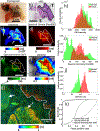First Clinical Results of Fluorescence Lifetime-enhanced Tumor Imaging Using Receptor-targeted Fluorescent Probes
- PMID: 35302604
- PMCID: PMC9167767
- DOI: 10.1158/1078-0432.CCR-21-3429
First Clinical Results of Fluorescence Lifetime-enhanced Tumor Imaging Using Receptor-targeted Fluorescent Probes
Abstract
Purpose: Fluorescence molecular imaging, using cancer-targeted near infrared (NIR) fluorescent probes, offers the promise of accurate tumor delineation during surgeries and the detection of cancer specific molecular expression in vivo. However, nonspecific probe accumulation in normal tissue results in poor tumor fluorescence contrast, precluding widespread clinical adoption of novel imaging agents. Here we present the first clinical evidence that fluorescence lifetime (FLT) imaging can provide tumor specificity at the cellular level in patients systemically injected with panitumumab-IRDye800CW, an EGFR-targeted NIR fluorescent probe.
Experimental design: We performed wide-field and microscopic FLT imaging of resection specimens from patients injected with panitumumab-IRDye800CW under an FDA directed clinical trial.
Results: We show that the FLT within EGFR-overexpressing cancer cells is significantly longer than the FLT of normal tissue, providing high sensitivity (>98%) and specificity (>98%) for tumor versus normal tissue classification, despite the presence of significant nonspecific probe accumulation. We further show microscopic evidence that the mean tissue FLT is spatially correlated (r > 0.85) with tumor-specific EGFR expression in tissue and is consistent across multiple patients. These tumor cell-specific FLT changes can be detected through thick biological tissue, allowing highly specific tumor detection and noninvasive monitoring of tumor EFGR expression in vivo.
Conclusions: Our data indicate that FLT imaging is a promising approach for enhancing tumor contrast using an antibody-targeted NIR probe with a proven safety profile in humans, suggesting a strong potential for clinical applications in image guided surgery, cancer diagnostics, and staging.
©2022 American Association for Cancer Research.
Conflict of interest statement
Figures





Similar articles
-
Fluorescence Lifetime-Based Tumor Contrast Enhancement Using an EGFR Antibody-Labeled Near-Infrared Fluorophore.Clin Cancer Res. 2019 Nov 15;25(22):6653-6661. doi: 10.1158/1078-0432.CCR-19-1686. Epub 2019 Sep 3. Clin Cancer Res. 2019. PMID: 31481509 Free PMC article.
-
Factors for Differential Outcome Across Cancers in Clinical Molecule-Targeted Fluorescence Imaging.J Nucl Med. 2022 Nov;63(11):1693-1700. doi: 10.2967/jnumed.121.263674. Epub 2022 Mar 24. J Nucl Med. 2022. PMID: 35332092 Free PMC article.
-
Panitumumab-IRDye800CW for Fluorescence-Guided Surgical Resection of Colorectal Cancer.J Surg Res. 2019 Jul;239:44-51. doi: 10.1016/j.jss.2019.01.065. Epub 2019 Feb 22. J Surg Res. 2019. PMID: 30798171 Free PMC article.
-
The multifaceted roles of peptides in "always-on" near-infrared fluorescent probes for tumor imaging.Bioorg Chem. 2022 Dec;129:106182. doi: 10.1016/j.bioorg.2022.106182. Epub 2022 Oct 19. Bioorg Chem. 2022. PMID: 36341739 Review.
-
Quicker, deeper and stronger imaging: A review of tumor-targeted, near-infrared fluorescent dyes for fluorescence guided surgery in the preclinical and clinical stages.Eur J Pharm Biopharm. 2020 Jul;152:123-143. doi: 10.1016/j.ejpb.2020.05.002. Epub 2020 May 8. Eur J Pharm Biopharm. 2020. PMID: 32437752 Review.
Cited by
-
Fluorescence Imaging-Assessed Surgical Margin Detection in Head and Neck Oncology by Passive and Active Targeting.Mol Diagn Ther. 2025 Jul;29(4):465-481. doi: 10.1007/s40291-025-00781-x. Epub 2025 May 8. Mol Diagn Ther. 2025. PMID: 40342044 Free PMC article. Review.
-
Fluorescence Lifetime Imaging Enables In Vivo Quantification of PD-L1 Expression and Intertumoral Heterogeneity.Cancer Res. 2025 Feb 1;85(3):618-632. doi: 10.1158/0008-5472.CAN-24-0880. Cancer Res. 2025. PMID: 39514403 Free PMC article.
-
In vivo quantification of programmed death-ligand-1 expression heterogeneity in tumors using fluorescence lifetime imaging.Res Sq [Preprint]. 2023 Oct 23:rs.3.rs-3222037. doi: 10.21203/rs.3.rs-3222037/v1. Res Sq. 2023. PMID: 37961361 Free PMC article. Preprint.
-
Image-guided cancer surgery: a narrative review on imaging modalities and emerging nanotechnology strategies.J Nanobiotechnology. 2023 May 18;21(1):155. doi: 10.1186/s12951-023-01926-y. J Nanobiotechnology. 2023. PMID: 37202750 Free PMC article. Review.
-
AUNP-12 Near-Infrared Fluorescence Probes across NIR-I to NIR-II Enable In Vivo Detection of PD-1/PD-L1 Axis in the Tumor Microenvironment.Bioconjug Chem. 2024 Jul 17;35(7):1064-1074. doi: 10.1021/acs.bioconjchem.4c00266. Epub 2024 Jul 9. Bioconjug Chem. 2024. PMID: 38980173 Free PMC article.
References
-
- van Keulen S, van den Berg NS, Nishio N, Birkeland A, Zhou Q, Lu G, Wang H-W, Middendorf L, Forouzanfar T, Martin BA, Colevas AD, and Rosenthal E, Rapid, non-invasive fluorescence margin assessment: Optical specimen mapping in oral squamous cell carcinoma. Oral oncology, 2019. 88: p. 58–65. - PMC - PubMed
-
- Gao RW, Teraphongphom N, de Boer E, van den Berg NS, Divi V, Kaplan MJ, Oberhelman NJ, Hong SS, Capes E, Colevas AD, Warram JM, and Rosenthal EL, Safety of panitumumab-IRDye800CW and cetuximab-IRDye800CW for fluorescence-guided surgical navigation in head and neck cancers. Theranostics, 2018. 8(9): p. 2488. - PMC - PubMed
Publication types
MeSH terms
Substances
Grants and funding
LinkOut - more resources
Full Text Sources
Medical
Research Materials
Miscellaneous

